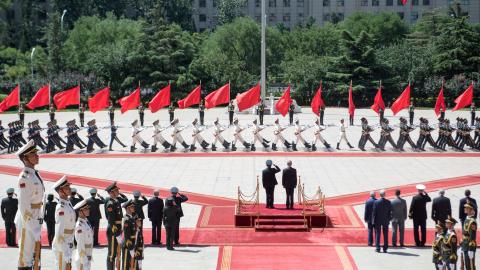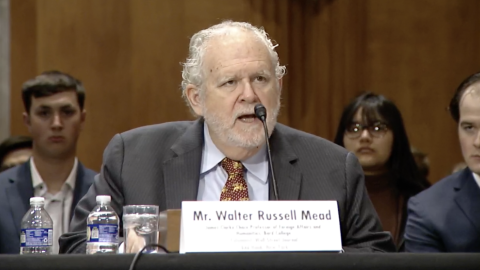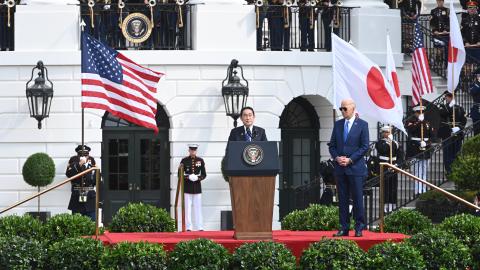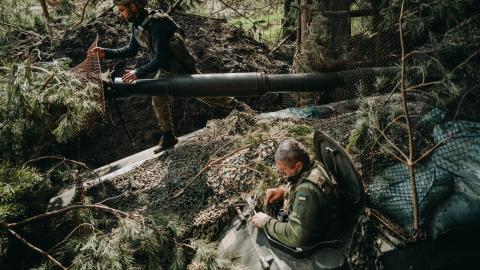Below Hudson Senior Fellow Can Kasapoğlu offers a military situation report about the war in Ukraine.
Executive Summary
- The Russian military focused on capturing Chasiv Yar, with hopes of using the tactically critical town in an anticipated summer campaign.
- Three thousand Wagner mercenaries moved to join the forces of pro-Kremlin Chechen strongman Ramzan Kadyrov.
- Russian glide bombs continued to bleed the Ukrainian Armed Forces.
- Drone-on-drone warfare intensified, offering a glimpse of the future of armed conflict.
1. Battlefield Assessment
This past week, Russian and Ukrainian forces continued positional fighting along multiple fronts, most notably in Donetsk and Kherson Oblasts and the Robotyne bulge, where Russia’s 58th Army led the fighting. Intense clashes also raged along the left bank of the Dnipro River.
The Kremlin is pushing along multiple axes to break Ukraine’s lines of defense. Russia is employing intensive heavy glide bomb salvos to break the stalemate in critical sectors, attack nested drone operators, capitalize on recent tactical gains, and eliminate Ukrainian positions around the cities of Bakhmut and Avdiivka, which Russian forces already control.
Geospatial evidence and battlefield reports indicate that Russian units are currently preparing for a new offensive. To that end, Moscow has focused its efforts on Chasiv Yar. Russian forces seek to use the city, which is situated on tactically important high ground, as a springboard to expand into deeper positions. Assault units have advanced toward the area, where Ukraine faces a pressing need to fortify its defenses.
New footage suggests that unmanned aerial vehicles (UAVs) are playing important roles in the fight for Chasiv Yar: a recent video shows a Russian Mavic drone identifying and destroying a Ukrainian long-endurance Baba Yaga UAV. The future of robotic warfare has already arrived on the battlefields of Ukraine.
Russia has also continued aerial attacks on Ukraine’s military facilities and civilian infrastructure. Between April 8 and 10, Russian forces hit several drone production plants inside Ukraine in strikes that employed modified S-300 and S-400 surface-to-air missile systems, Iranian Shahed loitering munitions, Iskander-M missiles, Kinzhal aeroballistic missiles, and several other unspecified projectiles. The Ukrainian Air Force’s interception rate against these munitions has now dropped below 70 percent, an alarmingly low figure.
Ukraine shot down almost every Shahed drone Russia used in its most recent assaults. But Kyiv was unable to neutralize any of Moscow’s S-300, S-400, and Kinzhal missiles, a consequence of the recent lull in Western military assistance. Ukraine’s supplies of Patriot and IRIS-T missiles and other air defense systems have either dropped to emergency levels or been depleted completely, leaving critical facilities such as power plants and defense manufacturing factories vulnerable to Russian strikes.
In the face of its slipping interception rates and depleted air defense assets, Ukrainian forces continued to conduct strikes against critical Russian military airbases. Reports suggest that the Ukrainian Main Intelligence Directorate (GUR) conducted a drone attack on Borisoglebsk Airbase in Voronezh in the early hours of April 9. Located 300 miles inside Russia, the Borisoglebsk facility hosts pilot training centers and, reportedly, repair and maintenance facilities for Russian military equipment.
Ukrainian intelligence also claimed that Kyiv used kamikaze drones to hit a Nebo-U long-range radar system in the Bryansk region of Russia. According to official reports, the Kremlin had been using the system for surveillance operations at least 430 miles inside Ukrainian territory. As casualties mount, both sides continue to rely heavily on unmanned assets, particularly land drones and unmanned ground vehicles (UGVs), though Russia’s current UGV models are prohibitively expensive and vulnerable to aerial drones.
Russia and Ukraine also continue intensive mobilization efforts. The United Kingdom’s Defence Intelligence suggests that Russia has begun its spring draft, from which Moscow expects to conscript roughly 150,000 men between the ages of 18 and 30 for summer service. Reportedly, Russia also is seeking to recruit approximately 400,000 contract personnel.
Similarly, Ukrainian President Volodymyr Zelenskyy recently signed a new mobilization law intended to improve his country’s force-to-force ratio with Russia. The legislation portends further efforts to expand mobilization in 2024. Zelenskyy also recently signed laws lowering the age of conscription to 25, introducing an electronic register for conscripts, and broadening eligibility for mobilization.
2. Estonia Moves to Meet Ukraine’s Imminent Need for Artillery Shells
Estonia announced that it will broker a comprehensive aid package for Ukraine centered around the provision of a large number of 155mm rounds. Per an announcement by Estonian Defense Minister Hanno Pevkur, the effort, in conjunction with recent Czech and British initiatives, aims to raise between 2 and 2.5 million shells for Ukraine this year. The Czech initiative will collectively spend $1.3 billion to procure 800,000 to 1 million shells, while Estonia will have to raise $2.2 billion among partner nations to acquire additional rounds from international weapons markets.
Open-source intelligence suggests that Ukraine is currently using its emergency ammunition reserves to counter Russian offensives in multiple locations. The suspension of American aid has put the Ukrainian military in a difficult position, especially given the artillery-driven character of the war. Any potential delay from Estonia could leave the already fragile Ukrainian front lines vulnerable to Russian attacks at a time when Moscow is bolstering its ammunition production capacity and rapidly diversifying its supply channels with significant support from China and North Korea.
3. A Large Group of Wagner Mercenaries Is Set to Join Chechen Akhmat Units
Chechnya’s pro-Kremlin strongman Ramzan Kadyrov announced that he is set to join forces with units formerly part of the Wagner private military company.
The Wagner commander known as Ratibor will join the Akhmat units of Kadyrov’s forces and bring some 3,000 mercenaries with him, vastly strengthening Kadyrov’s hand. Following former Wagner leader Yevgeny Prigozhin’s death, Wagner’s remaining forces have found themselves divided among the Russian National Guard (Rosgvardiya), the Russian Ministry of Defense, and military camps in Belarus, where they have been training Minsk’s armed forces. Now, Kadyrov will likely command a fourth group of Wagner mercenaries, helping ensure that the private army will continue to be a critical actor in Russia.
4. The Strategic Partnership between Beijing and Moscow Is Expanding at an Alarming Rate
Military and strategic ties between Beijing and Moscow are expanding at an alarming rate. The two sides are reportedly discussing boosting cooperation.
China’s role in Russia’s invasion of Ukraine is greater than either side acknowledges. Besides bolstering Russia’s arms supplies, Beijing reportedly also provides Moscow with other critical resources, including geospatial intelligence to facilitate aerial strikes on Ukrainian infrastructure and important components for arms production, such as microelectronics and other dual-use materials.














